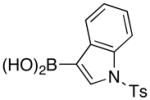Abstract
Pd2(dba)3/[HP(t-Bu)3]BF4/KF•2H2O serves as a mild, robust, and user-friendly method for the efficient Suzuki cross-coupling of a diverse array of aryl and heteroaryl halides with aryl- and heteroarylboronic acids.
Keywords: boron, cross-coupling, halides, palladium, water
Introduction
We and others have demonstrated that trialkylphosphines, including P(t-Bu)3 and PCy3, are unusually effective ligands for a range of coupling processes.1 This generalization includes the Suzuki reaction, which is perhaps the most widely used cross-coupling method for carbon–carbon bond formation.2,3,4
We have observed that the efficiency of Pd/P(t-Bu)3-catalyzed Suzuki reactions can vary significantly, depending on the batch of arylboronic acid that is used. We hypothesized that this might be due to differences in the amounts of arylboronic acid vs. anhydride (or water) that are present.5,6 Indeed, we determined that, under the standard conditions that we had described earlier,3c an arylboronic acid that had been dried under vacuum cross-couples in considerably lower yield than an arylboronic acid that had been freshly recrystallized from water [Eq. (1)].
 |
(1) |
In view of these observations, we decided to pursue the development of a new procedure for Pd/P(t-Bu)3-catalyzed Suzuki reactions that would be less dependent on the origin of the arylboronic acid. In this Update, we describe a method that we believe addresses this issue [Eq. (2)].
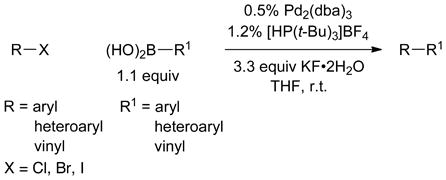 |
(2) |
Results and Discussion
In early experiments, we determined that the addition of a small amount of water to the “dried” arylboronic acid led to a more efficient Suzuki reaction (Table 1, entries 2–5).7,8 This suggested that, rather than employing anhydrous KF, it would be preferable to use the commercially available dihydrate (KF•2H2O; entry 2 vs. entry 6). In addition to restoring the efficiency of the Pd/P(t-Bu)3-catalyzed Suzuki cross-coupling, this modification has the added advantage of a very substantial cost savings (price per mole: anhydrous KF ($450/mol); KF•2H2O ($19/mol)).9 The procedure using KF•2H2O appears to be robust, providing good yields of the biaryl with a variety of boronic-acid sources (entries 6–8), as well as in the presence of additional water (entry 9).
Table 1.
Effect of reaction conditions on Pd/P(t-Bu)3-catalyzed Suzuki cross-couplings.
 | ||||
|---|---|---|---|---|
| entry | boronic acid | KF | added water | yield (%)a |
| 1 | recrystallized from water | dryb | none | 96 |
| 2 | driedc | dryb | none | 14 |
| 3 | driedc | dryb | 1 equiv | 87 |
| 4 | driedc | dryb | 2 equiv | 88 |
| 5 | driedc | dryb | 4 equiv | 92 |
| 6 | driedc | dihydrate | none | 94 |
| 7 | recrystallized from water | dihydrate | none | 97 |
| 8 | as received | dihydrate | none | 97 |
| 9 | recrystallized from water | dihydrate | 2 equiv | 97 |
All data are the average of two experiments.
The yield was determined by 1H NMR spectroscopy vs. an internal standard.
Anhydrous (Aldrich).
Heated at 120 °C at 300 mtorr for 1.0 h.
For small-scale reactions and/or for parallel synthesis, weighing small amounts of Pd2(dba)3 and P(t-Bu)3 or [HP(t-Bu)3]BF4 can be tedious and inaccurate.10 To circumvent these issues, we recommend the use of a pre-made mixture of Pd2(dba)3/[HP(t-Bu)3]BF4 (Pd:P(t-Bu)3 = 1:1.2) as a convenient one-component source of palladium and P(t-Bu)3 (see the Supporting Information).11
The Pd2(dba)3/[HP(t-Bu)3]BF4/KF•2H2O procedure can be applied to Suzuki cross-couplings of a wide array of substrates.12 Thus, a variety of aryl bromides are suitable reaction partners, including hindered (entries 1–3) and deactivated (entry 4) compounds. In addition, an aryl bromide can be cross-coupled selectively in the presence of an aryl chloride (entry 5). Furthermore, a range of nitrogen-containing heteroaryl bromides and heteroarylboronic acids are useful reaction partners (entries 6–10).
Not only aryl bromides, but also aryl iodides [Eq. (3)] and vinyl bromides [Eq. (4)], undergo Suzuki coupling under this standard set of conditions. In addition, Pd2(dba)3/[HP(t-Bu)3]BF4/KF•2H2O can achieve cross-couplings of a variety of activated aryl chlorides with an array of arylboronic acids (Table 3).13 Both nitrogen and sulfur heterocycles are tolerated (entries 4–7), as are a wide range of substituents. Alkenylboronic acids are also suitable coupling partners (entry 7).
Table 3.
Suzuki cross-couplings of activated aryl and heteroaryl chlorides with aryl-, heteroaryl-, and alkenylboronic acids (for the reaction conditions, see Eq. (2)).
Yield of purified product (average of two experiments).
The isolated biaryl product is a 4:1 mixture of the aldehyde and its hydrate.
 |
(3) |
 |
(4) |
Conclusions
In summary, we have developed a versatile, user-friendly method for Suzuki reactions that employs a commercially available one-component source of Pd/P(t-Bu)3, as well as an inexpensive activator. Thus, Pd2(dba)3/[HP(t-Bu)3]BF4/KF•2H2O accomplishes cross-couplings of a diverse set of aryl/heteroaryl halides with a range of aryl/heteroarylboronic acids at room temperature in good yield. The reaction components are air-stable, and the method is not moisture-sensitive. We anticipate that this procedure may prove useful to others.
Experimental Section
General Procedure for Pd/P(t-Bu)3-Catalyzed Suzuki Cross-Couplings
Pd2(dba)3/[HP(t-Bu)3]BF4 (Pd:P(t-Bu)3 = 1:1.2; 8.1 mg, 0.0050 mmol of Pd2(dba)3), the boronic acid (1.10 mmol), and KF•2H2O (310 mg, 3.30 mmol) were added to a 4-mL vial that contained a stir bar. The vial was purged with argon for 3 min, and then it was sealed with a septum cap. THF (2.0 mL) and the aryl halide (1.00 mmol) were added, and the reaction mixture was stirred at room temperature. Next, the mixture was diluted with Et2O (2 mL) and filtered through a plug of silica gel (washed with Et2O (10 mL)). The filtrate was concentrated, and the residue was purified by flash chromatography on silica gel.
Supplementary Material
Acknowledgments
Support has been provided by the National Institutes of Health (National Institute of General Medical Sciences, grant R01–GM62871), Merck Research Laboratories, and Novartis. We thank Dr. Xing Dai for a preliminary study.
Footnotes
Supporting information for this article is available on the WWW under http://**
General information and compound characterization data are available as Supporting Information.
References
- 1.For leading references, see: Fu GC. Acc Chem Res. 2008;41:1555–1564. doi: 10.1021/ar800148f.
- 2.For reviews, see: de Meijere A, Diederich F, editors. Metal-Catalyzed Cross-Coupling Reactions. Wiley–VCH; New York: 2004. Negishi E-i., editor. Handbook of Organopalladium Chemistry for Organic Synthesis. Wiley–Interscience; New York: 2002.
- 3.For the development of methods for Pd/P(t-Bu)3- and Pd/PCy3-catalyzed Suzuki reactions, see: Littke AF, Fu GC. Angew Chem Int Ed. 1998;37:3387–3388. doi: 10.1002/(SICI)1521-3773(19981231)37:24<3387::AID-ANIE3387>3.0.CO;2-P.Littke AF, Dai C, Fu GC. J Am Chem Soc. 2000;122:4020–4028.Netherton MR, Fu GC. Org Lett. 2001;3:4295–4298. doi: 10.1021/ol016971g.Kudo N, Perseghini M, Fu GC. Angew Chem Int Ed. 2006;45:1282–1284.
- 4.For a few recent examples of applications of Pd/P(t-Bu)3-catalyzed Suzuki reactions, see: Amaya T, Nakata T, Hirao T. J Am Chem Soc. 2009;131:10810–10811. doi: 10.1021/ja9031693.Huang W, Su L, Bo Z. J Am Chem Soc. 2009;131:10348–10349. doi: 10.1021/ja9033846.Ihara H, Suginome M. J Am Chem Soc. 2009;131:7502–7503. doi: 10.1021/ja902314v.
- 5.For an example of related, independent observations by others, see: Antoft-Finch A, Blackburn T, Snieckus V. J Am Chem Soc. 2009;131:17750–17752. doi: 10.1021/ja907700e.
- 6.For an overview of boronic acids, see: Hall DG, editor. Boronic Acids. Wiley–VCH; Weinheim: 2005.
- 7.We have previously described the use of dioxane/water as a solvent for Pd/PCy3-catalyzed Suzuki reactions (Reference 3d).
- 8.For examples of reports of the beneficial effect of water on Pd/P(t-Bu)3-catalyzed Suzuki reactions, see: Lewis RT, Blackaby WP, Blackburn T, Jennings ASR, Pike A, Wilson RA, Hallett DJ, Cook SM, Ferris P, Marshall GR, Reynolds DS, Sheppard WFA, Smith AJ, Sohal B, Stanley J, Tye SJ, Wafford KA, Atack JR. J Med Chem. 2006;49:2600–2610. doi: 10.1021/jm051144x.Handy ST, Mayi D. Tetrahedron Lett. 2007;48:8108–8110. doi: 10.1016/j.tetlet.2007.09.114.Fray MJ, Gillmore AT, Glossop MS, McManus DJ, Moses IB, Praquin CFB, Reeves KA, Thompson LR. Org Process Res Dev. 2010;14:263–271.
- 9.Aldrich (online prices on 31 March 2010): anhydrous KF ($196/25 g); KF•2H2O ($100/500 g).
- 10.The Pd:P(t-Bu)3 ratio has an impact on the rate of cross-coupling. For a discussion, see Reference 3b.
- 11.Pd2(dba)3/[HP(t-Bu)3]BF4 (Pd:P(t-Bu)3 = 1:1.2) is available from Strem Chemicals (catalog number 46-3015). We have observed that Pd2(dba)3/[HP(t-Bu)3]BF4 can be exposed to air for seven months without a change in its activity as a Suzuki cross-coupling catalyst.
- 12.a) Under our standard conditions: aryltrifluoroborates and pinacolboronate esters are not suitable cross-coupling partners; replacement of HP(t-Bu)3]BF4 with [HPCy3]BF4 results in a slower reaction; b) A gram-scale reaction (entry 1 of Table 2) proceeded in 97% yield (1.14 g); c) According to 1H NMR spectroscopy, the addition of water to the “dried” arylboronic acid in THF at room temperature led to rapid formation of the arylboronic acid.
- 13.For unactivated aryl chlorides, the catalyst system described in Reference 3d is more effective than the method provided in Eq. (2).
Table 2.
Suzuki cross-couplings of aryl and heteroaryl bromides with aryl-, heteroaryl-, and alkenylboronic acids (for the reaction conditions, see Eq. (2)).
| entry | aryl bromide | boronic acid | yield (%)a |
|---|---|---|---|
| 1 | 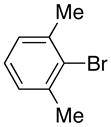 |
 |
96 |
| 2 |  |
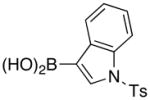 |
95 |
| 3 |  |
 |
98 |
| 4 |  |
84 | |
| 5 |  |
98 | |
| 6 |  |
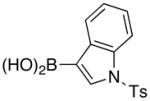 |
93 |
| 7 |  |
 |
82 |
| 8 |  |
 |
95 |
| 9 |  |
 |
76 |
| 10 |  |
 |
87 |
Yield of purified product (average of two experiments).
**mass balance for entry 9**
Associated Data
This section collects any data citations, data availability statements, or supplementary materials included in this article.











